![]()
Whitefriars and other English Paperweights for Sale
![]()
Whitefriars and other English Paperweights for Sale
A quick summary of English paperweight production is given below. See the excellent book Old English Paperweights by Robert Hall for more detail.
Modern Whitefriars paperweights are prized by collectors for their high quality glass and millefiori designs. The limited edition paperweights with mosaic canes are especially sought.
In addition to the millefiori paperweights discussed above, there is another category of collectible English paperweights. Green glass paperweights, mantle ornaments and doorstops originated as early as 1820 and continued to be made as late as 1914. They are made from green and blue bottle glass in factories founded by John Kilner of Wakefield and other bottle makers in the Midlands and Northern regions. There are articles on this topic in 2002, 2003 and 2005 annual bulletins of the Paperweight Collectors Association. You can also read about them in Hall's Old English Paperweights by Robert Hall. Often referred to as green dumps, the most desirable are those with well executed floral designs, sulphide inclusions, or colored flowers. Even more desirable is a signed example. Since they are made form bottle glass, these paperweights often show signs of rough handling with chips or internal fractures.
If you would like to purchase
any of these paperweights, e-mail me at: aport@paperweights.com
| 6258 | Whitefriars 1975 Christmas Millefiori
Paperweight - Host of Angels. dated 1975.
This is a hard to find Whitefriars Christmas paperweight featuring
a large millefiori mosaic of an angel in the center. It is
the first Christmas design made by Whitefriars. The angel is
surrounded by a ring of blue and white star canes plus a
Whitefriars signature cane having a white monk and the year
1975. The center design is surrounded by a ring of smaller
angel canes and then two rings of complex green canes.
Underneath is an opaque black button ground. This
paperweight was issued in a limited edition of 1,000 paperweights
of which all were sold, including 329 to the United States.
It comes with its original (but marked up) certificate stating
that it is number 543 in a limited edition of 1,000
paperweights. The number 543 is also engraved on the
base. It is faceted with one top facet and five side
facets. A marvelous paperweight.
The Whitefriars Christmas paperweights were limited editions
made in 1975 through 1980, each with a different Christmas
theme. 1975 was the first time a paperweight had been
produced using the new mosaic picture technique developed by
Geoff Baxter. The mosaic canes proved to be an outstanding
success. The canes were designed by Geoff Baxter and made
by Ray Annenburg who started working at Whitefriars in 1953 and
became their chief cane maker in 1972. The design of the
1975 paperweight is based on Luke 2:9 "and suddenly there was
with the angel a multitude of the Heavenly Host". Large size: 3 1/16" diameter by 1 13/16"
high. The base is ground concave and is engraved with the
edition number 543. It is faceted with one top facet and
five side facets. For extra pictures, click on the picture at the right and the following links: Large picture$395 postage paid in the US. Click on the picture to see a larger image. |
Click
on the picture to see a larger image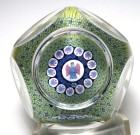 |
| 4016 | Large Mdina Glass Swirl
Paperweight. circa 1968-1985. Wonderful
paperweight with a dark interior of red, green, blue, yellow, and
other colors. There are additional swirls that surround the
core and extend out to the surface. The glass encasement is
a dark grey or green. Made on the island of Malta in the
Mediterranean Sea. It is signed "Mdina"in script on the
base. Mdina Glass was founded on the Island of Malta in 1968 by Michael Harris (1933-1994) and Eric Dobson with financial incentives and the encouragement of the Maltese government. Initially it was called the Maltese Glass Industries, but the name was changed to Mdina Glass shortly later. Michael Harris received his training in glass at several institutions graduating from the Royal College of Art in London in 1959. He later became an RCA tutor setting up hot glass facilities there in 1967. He was a pioneer of the studio glass movement in the UK. Eric Dobson was also at the Royal College of Art. Mdina Glass was a successful venture and gave rise to a significant glass craft industry on the Island of Malta. Michael Harris left Malta in 1972 to establish Wight Glass in the UK. In 1971, two Italian maestros, the father and son team of Vincente and Ettore Boffo joined Mdina Glass to introduce Italian glassmaking techniques. Eric Dobson continued until about 1985 working with the local glass artists that he and Michael had trained. Eventually Mdina Glass was taken over by Joseph Said, a Maltese glassworker who had trained at Mdina. For context, during this period Malta gained independence from Britain in 1964 after 150 years as a British colony. In 1974 it became the Republic of Malta, and in 2004 joined the European Union. Large Size: 3" diameter and just under 4 1/4"
high. The bottom is fire finished with a left hand flame
pontil mark. For extra pictures, click on the picture at the right and the following links: Large picture SOLD. Click on the picture to see a larger image. |
Click
on the picture to see a larger image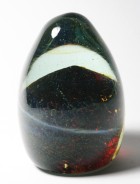 |
| 5695 | Whitefriars 1976 Bicentennial Liberty
Bell Limited Edition Millefiori Paperweight
with Certificate. circa 1976. This Whitefriars
paperweight has a central picture cane depicting the Liberty
Bell. It is surrounded by thirteen white stars each with a
blue background. There is a special Whitefriars signature
cane with a white monk and the years 1776 and 1976. It also
has its original paper label with a Whitefriars monk symbol and
the text "WHITEFRIARS FULL LEAD CRYSTAL MADE IN ENGLAND".
The colors are red, white, and blue to celebrate the 200th
anniversary of the signing of the American Declaration of
Independence on July 4, 1776. This weight is numbered 416 on
the base. The paperweight also comes with its original
certificate which states that it is number 416 in a limited
edition of 750 paperweights. The paperweight is made using
full lead crystal which gives it a brilliant finish. It is
faceted with a top facet and five side facets. Modern Whitefriars paperweights are prized by collectors for their high quality glass and millefiori designs. The limited edition paperweights with mosaic canes are especially sought after. The name Whitefriars Glass dates from sometime in the 1600s. The original site had been occupied by a community of Carmelite monks known as White Friars, hence the name taken by the glass company. Some sources state that at least a portion of the company operated under the name of James Powell and Sons from 1834 to 1962. Other sources state that the Whitefriars name was used from 1680 to 1980. Limited production of millefiori paperweights and other millefiori items started some time in the 1930s and first appeared in the 1938 catalog. Millefiori items were made using English full lead crystal (33% lead oxide). It is difficult to associate specific paperweights with this production. After 1945, they made colored glass and bubble design paperweights until the modern millefiori production started about 1951. Even then relatively few designs were produced until the 1970s. In 1980, Whitefriars glass went out of business. After Whitefriars Glass was liquidated, Caithness Glass purchased the rights to the name and produced paperweights under the Whitefriars name for a while. For a long time, collectors believed that English paperweights and inkwells dated 1848 and similar undated items were made by Whitefriars. The dates, however, are false dates and have been traced to production at Arculus and Walsh-Walsh in the 1920s and 1930s. Most paperweights referred to as old Whitefriars or antique Whitefriars were, in fact, made by other factories such as Richardson, Arculus, Walsh-Walsh, or one of the unidentified Old English factories. When the maker can not be identified, it is best to call them Old English paperweights and not associate them with Whitefriars. Size: 3 1/8" diameter by 1 3/4" high. The
base is ground concave. Faceted with one top facet and five side
facets. For extra pictures, click on the picture at the right and the following links: Large pictureSOLD. Click on the picture to see a larger image. |
Click
on the picture to see a larger image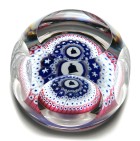 |
| 4032 | Colorful Guernsey Island Studio
Paperweight with Silverplate Base by Sileda Ltd. dated
1986. This colorful glass paperweight was most
likely made by the Guernsey Island Studio (also known as Guernsey
Glass). The Sheffield silverplate base was added by Sileda
Ltd. (Wales) and has the silver marks indicating Sileda was the
maker of the base and it was made in 1986. There are several
discussions on the Internet about this type of paperweight and I
was able garner the basic facts about the makers and the date (see
below). The silver plate has been lost some of its silver
layer and the underlying copper is visible. There is a felt
cover in the center base. I did not remove the felt to see
if there was a Guernsey mark on the glass. This is an odd
item, but it will make a good conversation piece. Guernsey Island Studio (also known as Guernsey Glass) was located at the Oatlands Craft Centre, St Sampson, Guernsey, Channel Islands. It was founded about 1980 with advice and assistance from Michael Harris of the Isle of Wight Studio Glass. They made small souvenir pieces, such as vases, animal figures, and paperweights and often marked them on the base with the trademark Guernsey mark, which was three lions passant on a shield. They closed sometime in the 1990s. Sileda Ltd was founded in Cefn-y-bedd Wales UK about 1980. They were a small silver company that registered their punches at the Sheffield Assay Office from 1980 to 2000. The makers mark is "SL" with a small indent between the two letters. In addition to any other silver work they may have done, they were known for sourcing (purchasing) glass objects such as paperweights and vases from UK glass studios and adding silver enhancements or decorations to the glass objects. For paperweights, the enhancement was a silverplate base, for vases it was often a silver collar. In many cases, collectors could identify the original source of the glass object. Size: 2 3/4" diameter by 1 15/16" high. The
base is covered with a silverplate covering and a felt cover in
the center. I did not remove the felt to see if the
Guernsey mark is under the felt. For extra pictures, click on the picture at the right and the following links: Large pictureSOLD. Click on the picture to see a larger image. |
Click on the picture
to see a larger image 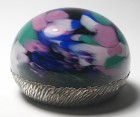 |
| 4281 | Large Whitefriars Faceted Six Ring Red
White & Blue Concentric Millefiori Paperweight. dated
1975. This paperweight has six concentric rings of red,
white, and blue millefiori canes around a center cane with a star
center. The ground is clear crystal. Typical heavy
Whitefriars lead crystal. The paperweight is faceted with a
large top facet and five large side facets. It has a
Whitefriars signature cane with a white monk and the date 1975 in
the outermost white ring (the fifth ring from the center) and also
has a paper label used starting in 1970. With its bold
colors, this is a very nice addition to any collection of
millefiori paperweights. Modern Whitefriars paperweights are prized by collectors for their high quality glass and millefiori designs. The paperweights with mosaic canes are especially sought after. The name Whitefriars Glass dates from sometime in the 1600s. The original site had been occupied by a community of Carmelite monks known as White Friars, hence the name taken by the glass company. Some sources state that at least a portion of the company operated under the name of James Powell and Sons from 1834 to 1962. Other sources state that the Whitefriars name was used from 1680 to 1980. Limited production of millefiori paperweights and other millefiori items started some time in the 1930s and first appeared in the 1938 catalog. Millefiori items were made using English full lead crystal (33% lead oxide). It is difficult to associate specific paperweights with this production. After 1945, they made colored glass and bubble design paperweights until the modern millefiori production started about 1951. Even then relatively few designs were produced until the 1970s. In 1980, Whitefriars glass went out of business. After Whitefriars Glass was liquidated, Caithness Glass purchased the rights to the name and produced paperweights under the Whitefriars name for awhile. Large size: 3 1/8" diameter by 1 7/8" high.
The base is ground concave. Faceted with a total of one
large top facet and five large side facets. For extra pictures, click on the picture at the right and the following links: Large picture$295 postage paid in the US. Click on the picture to see a larger image. |
Click
on the picture to see a larger image 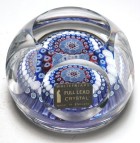 |
| 5238 | Mdina Glass Swirl Paperweight with Knob
/ Handle. circa 1968-1985. Wonderful
paperweight with a dark swirling interior of green, blue, brown,
white, and other colors. The paperweight has a knob or
handle on top. The knob has some swirls of amber glass plus
bits of white glass in it. Made on the island of Malta in
the Mediterranean Sea. It is signed "Mdina"in script on the
base. Note on condition: This paperweight has two popped bubbles on the surface of the glass. They are not damage, but I am mentioning them for completeness. The larger of the bubbles is shown in one of the pictures. Mdina Glass was founded on the Island of Malta in 1968 by Michael Harris (1933-1994) and Eric Dobson with financial incentives and the encouragement of the Maltese government. Initially it was called the Maltese Glass Industries, but the name was changed to Mdina Glass shortly later. Michael Harris received his training in glass at several institutions graduating from the Royal College of Art in London in 1959. He later became an RCA tutor setting up hot glass facilities there in 1967. He was a pioneer of the studio glass movement in the UK. Eric Dobson was also at the Royal College of Art. Mdina Glass was a successful venture and gave rise to a significant glass craft industry on the Island of Malta. Michael Harris left Malta in 1972 to establish Wight Glass in the UK. In 1971, two Italian maestros, the father and son team of Vincente and Ettore Boffo joined Mdina Glass to introduce Italian glassmaking techniques. Eric Dobson continued until about 1985 working with the local glass artists that he and Michael had trained. Eventually Mdina Glass was taken over by Joseph Said, a Maltese glassworker who had trained at Mdina. For context, during this period Malta gained independence from Britain in 1964 after 150 years as a British colony. In 1974 it became the Republic of Malta, and in 2004 joined the European Union. Size: Just under 2 1/2" diameter by 3
7/16" high. The bottom is polished flat.. For extra pictures, click on the picture at the right and the following links: Large picture $45 postage paid in the US.
Click on the picture to see a larger image. |
Click on the picture
to see a larger image 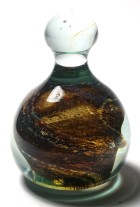 |
|
|
Whitefriars 1978 Christmas Millefiori
Paperweight - The Journey to Bethlehem. dated
1978. This is a hard to find Whitefriars Christmas
paperweight featuring a millefiori mosaic of the Mary and Joseph
on their journey to Bethlehem guided by the Star of Bethlehem
shining above them. Mary is depicted riding a donkey with
Joseph leading the way on foot. There is a light blue carpet
ground of complex millefiori canes surrounding the mosaic and also
a two ring millefiori garland of complex canes on the
outside. It is signed in the design with a Whitefriars
signature cane having a white monk and the year 1978. It
also has a worn Whitefriars paper label with a white silhouette of
a monk and the text "WHITEFRIARS FULL LEAD CRYSTAL MADE IN
ENGLAND". This paperweight was issued in a limited edition
of 1,000 paperweights of which only 610 were sold, including 102
to the United States. A marvelous paperweight.
The Whitefriars Christmas paperweights were limited editions made in 1975 through 1980, each with a different Christmas theme. The central pictorial mosaic cane was created by Ray Annenburg. Ray started working at Whitefriars in 1953 and became their chief cane maker in 1972. Modern Whitefriars paperweights are prized by collectors for their high quality glass and millefiori designs. The paperweights with mosaic canes are especially sought after. The name Whitefriars Glass dates from sometime in the 1600s. The original site had been occupied by a community of Carmelite monks known as White Friars, hence the name taken by the glass company. Some sources state that at least a portion of the company operated under the name of James Powell and Sons from 1834 to 1962. Other sources state that the Whitefriars name was used from 1680 to 1980. Limited production of millefiori paperweights and other millefiori items started some time in the 1930s and first appeared in the 1938 catalog. Millefiori items were made using English full lead crystal (33% lead oxide). It is difficult to associate specific paperweights with this production. After 1945, they made colored glass and bubble design paperweights until the modern millefiori production started about 1951. Even then relatively few designs were produced until the 1970s. In 1980, Whitefriars glass went out of business. After Whitefriars Glass was liquidated, Caithness Glass purchased the rights to the name and produced paperweights under the Whitefriars name for a while. Large size: 3 1/16" diameter by 1 7/8" high.
The base is ground concave. Faceted with one top facet and five
side facets. For extra pictures, click on the picture at the right and the following links: Large pictureSOLD. Click on the picture to see a larger image. |
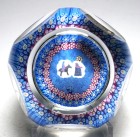 |
|
|
Large Whitefriars Early Faceted Six Ring
Concentric Millefiori Paperweight. dated 1970.
This paperweight has six concentric rings of canes (blue, white,
turquoise, dark blue, red, and white) around a larger center cane
with a star center. The ground is clear crystal.
Typical heavy Whitefriars lead crystal. The paperweight is
faceted with a large top facet and five large side facets.
It has a Whitefriars signature cane with a white monk and the date
1970 in the outermost white ring and also has an early paper label
used from the mid 1950s into the early 1970s. With its bold
colors, this is a very nice addition to any collection of
millefiori paperweights. Modern Whitefriars paperweights are prized by collectors for their high quality glass and millefiori designs. The paperweights with mosaic canes are especially sought after. The name Whitefriars Glass dates from sometime in the 1600s. The original site had been occupied by a community of Carmelite monks known as White Friars, hence the name taken by the glass company. Some sources state that at least a portion of the company operated under the name of James Powell and Sons from 1834 to 1962. Other sources state that the Whitefriars name was used from 1680 to 1980. Limited production of millefiori paperweights and other millefiori items started some time in the 1930s and first appeared in the 1938 catalog. Millefiori items were made using English full lead crystal (33% lead oxide). It is difficult to associate specific paperweights with this production. After 1945, they made colored glass and bubble design paperweights until the modern millefiori production started about 1951. Even then relatively few designs were produced until the 1970s. In 1980, Whitefriars glass went out of business. After Whitefriars Glass was liquidated, Caithness Glass purchased the rights to the name and produced paperweights under the Whitefriars name for awhile. Large Size: Just over 3" diameter by 1 7/8"
high. The base is ground concave. Faceted with a
total of one large top facet and five large side facets. For extra pictures, click on the picture at the right and the following links: Large picture$275 postage paid in the US. Click on the picture to see a larger image. |
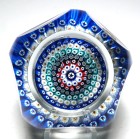 |
|
5635
|
Webb Corbett Purple Flash Overlay Paperweight
with Certificate. 1969-1986. This Webb Corbett
paperweight was produced during the period that Webb Corbett was
owned by Royal Doulton. It has a clear interior with no
inner design and a transparent purple (or amethyst) flash
overlay. It is finished with one top facet, five side
facets, and a star cut base. It has its original foil label
"FINEST ENGLISH FULL LEAD CRYSTAL ROYAL DOULTON MADE IN
ENGLAND". It also comes with its original Webb Corbett
certificate declaring "Webb Corbett Fine English Hand Made Crystal
PURPLE MULTI HOLLOW PAPERWEIGHT" and giving a history of the
company. Webb Corbett is one of the great
names in English lead-crystal glass. It was set up in 1897 by
two grandsons of Thomas Webb I, Herbert Webb and Thomas Webb
III, together with George Harry Corbett. The original
company name was Thomas Webb and Corbett Limited. It was
a separate operation from Thomas Webb and Sons. Thomas
Webb and Corbett Ltd changed their name to Webb Corbett Ltd in
the 1930's. In 1969 the company was taken over by Royal
Doulton and in 1986 they stopped using the Webb Corbett
name. Glass from the former Webb Corbett glassworks was
then produced under the name Royal Doulton Crystal until this
glassworks closed down. After several mergers and
reorganizations, Royal Doulton Crystal is now owned by the
Finnish company Fiskars Corporation, along with Waterford
Crystal, Wedgwood, and Iittala. David Smith was the
chief designer at Webb Corbett from 1965 until he left in
1982. He introduced a magnificent range of cameo glass designs
using clear crystal with an overlay of colored glass.
The design was produced by sand blasting the glass to remove
part of the colored layer. For extra pictures, click on the picture at the right and the following links: Large picture$49 postage paid in the US. Click on the picture to see a larger image. |
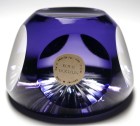 |
| 4042 | Kris Heaton Neo Art Glass Iridescent
Silver Heart Paperweight with Butterfly. circa
2000. Magical design featuring a free form iridescent silver
heart and metal butterfly butterfly. The spotted surface
creates the impression a floating leaf where the butterfly has
come to rest. It is signed on the base with a foil label
"Neo Art Glass By K. Heaton" and is also engraved "K Heaton". Kris Heaton (born 1977) is a glass artist from Blackpool, Lancashire, England. He started working in glass at age sixteen as an apprentice to John Ditchfield, (Glasform). Under John’s tuition, Kris developed the skills required to become an independent master glassblower in his own right. His work allows free expression to sculpt molton glass into visual art forms. He now works in his own studio, Neo Art Glass, in Blackpool. Large Size: 3 7/8" long by 2 3/4" wide by 1
3/16" thick. The metal butterfly is about 3/4" by
3/4". The base is ground concave. For extra pictures, click on the picture at the right and the following links: Large pictureSOLD. Click on the picture to see a larger image. |
Click
on the picture to see a larger image |
| 4309 | Large Iridized Royal Brierley Studio
(Isle of Wight Studio Glass) Paperweight. 1988-1991.
Wonderful patterned paperweight made at the Isle of Wight Studio
Glass as part of their Royal Brierley Studio line. It was
designed by Elizabeth Harris. I believe the pattern is
either the Silk or Lace finish and it features an iridized
metallic pattern on the surface with a brilliant blue core.
It is signed on the base with an acid etched "Royal Brierley
Studio" - although the etch was applied in
reverse. There is a lot of confusion on the web as to the origin of the Royal Brierley Studio glass line which was made by the Isle of Wight Studio Glass, Old Park, St Lawrence during the period 1985-2000. The confusion is because of the existence of another company named Royal Brierley Crystal. Isle of Wight Studio Glass was established in 1973 by one of the founders of the British Studio Glass Movement, Michael Harris (1933 – 1994). Michael graduated from the Royal College of Art in 1959 and later became an RCA tutor, setting up hot glass facilities there in 1967. The following year he founded Mdina Glass in Malta, remaining there until 1972, when he moved back to the UK. In 1973, with his wife Elizabeth Harris, he founded Isle of Wight Studio Glass, in Old Park, St Lawrence where it continued until his premature death in 1994. The glass studio continued to operate under the guidance of his son Timothy Harris until 2012. It is worth mentioning that there is also a Royal Brierley Crystal which had a brief connection to the design activity that became Royal Brierley Studio line – but was not the same company. Royal Brierley Crystal traced its origins to Smith & Williams Glass (founded 1846) and before that to Brierley Hill Glass Works (founded in 1740). In the mid 1970s, Catherine Hough was the Artist in Residence for two years at Royal Brierley Crystal. She was experimenting with enameling and electroplating on her blown objects. Royal Brierley Crystal was interested in creating a newer product line of studio glass and Hough assisted in the establishment of a Studio at Royal Brierley Crystal. Michael Harris was commissioned to design these pieces which had an iridized finish over red or blue (Loetz-like). The Studio effort was short lived and ended about 1982, but some of the design ideas were continued by Michael Harris and Elizabeth Harris at the Isle of Wight Studio Glass. Large Size: 3 1/16" diameter and just under 2
11/16" high. The base is polished concave. For extra pictures, click on the picture at the right and the following links: Large picture $125 postage paid in the US.
Click on the picture to see a larger image. |
Click
on the picture to see a larger image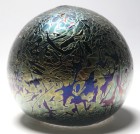 |
| 3015 | Magnum Whitefriars Pattern 9850 Pink
Streaky Abstract Paperweight. circa
1978-1980. This paperweight has a distinctive swirl pattern
created by picking up red, yellow, and pink colored glass
stringers (rods). It has typical heavy Whitefriars lead
crystal. This is pattern 9850 and it has a label identifying
it as such. It has its original (slightly worn) Whitefriars
paper label on the side near the base. The label has a
Whitefriars monk symbol and the text "WHITEFRIARS FULL LEAD
CRYSTAL MADE IN ENGLAND". It also has label identifying the
pattern as "9850". A great addition to any collection of
modern English paperweights. The pattern "9850" was introduced in 1978 by Geoffrey Baxter. The paper label with the number "9850" has an added handwritten "A" and another number "9793". To the best of my knowledge, there is no pattern 9793, so this is probably an error. It may have been a reference to 9893 which was a version introduced in 1980 by Ray Annenberg (which would also explain the "A"). The Whitefriars Paperweights Collectors Guide by Brian Slingsby and Judy Taylor refers the group of designs (9850, 9851, 9893, & 9894) with this style of abstract as "Bubble & Streaky". Streaky weights came with and without a controlled bubble pattern in a variety of colors. They were made in the 1978 to 1980 time frame. Modern Whitefriars paperweights are prized by collectors for their high quality glass and millefiori designs. The limited edition paperweights with mosaic canes are especially sought after. The name Whitefriars Glass dates from sometime in the 1600s. The original site had been occupied by a community of Carmelite monks known as White Friars, hence the name taken by the glass company. Some sources state that at least a portion of the company operated under the name of James Powell and Sons from 1834 to 1962. Other sources state that the Whitefriars name was used from 1680 to 1980. Limited production of millefiori paperweights and other millefiori items started some time in the 1930s and first appeared in the 1938 catalog. Millefiori items were made using English full lead crystal (33% lead oxide). It is difficult to associate specific paperweights with this production. After 1945, they made colored glass and bubble design paperweights until the modern millefiori production started about 1951. Even then relatively few designs were produced until the 1970s. In 1980, Whitefriars glass went out of business. After Whitefriars Glass was liquidated, Caithness Glass purchased the rights to the name and produced paperweights under the Whitefriars name for awhile. Very large size: 3 3/8" diameter by 2 7/8"
tall. The bottom is polished concave. This
paperweight is heavy and weighs almost 34 ounces. For extra pictures, click on the picture at the right and the following links: Large picture$145 postage paid in the US. Click on the picture to see a larger image. |
Click
on the picture to see a larger image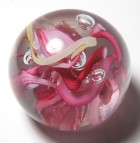 |
| 5685 | Rare Whitefriars 1976 Bicentennial
Millefiori Flag Limited Edition Paperweight - damaged.
circa 1976. This is a hard to find Whitefriars Bicentennial
Paperweight featuring a millefiori mosaic of the American
Flag. There are thirteen blue and white canes for stars and
four red and three white canes for the stripes. A gold cane
makes provides a staff . In the background there is a white
and gold carpet ground of millefiori canes and also a millefiori
garland of blue and white canes on the outside. This weight
is numbered 135 on the base. There is a special Whitefriars
signature cane with a white monk and the years 1776 and
1976. It also has its original paper label with a
Whitefriars monk symbol and the text "WHITEFRIARS FULL LEAD
CRYSTAL MADE IN ENGLAND". The paperweight also comes with
its original (wrinkled) certificate which states that it is number
135 in a limited edition of 150 paperweights. The
paperweight is made using full lead crystal which gives it a
brilliant finish. It is faceted with a top facet and five
side facets.
This is an especially rare Whitefriars paperweight.
Although the edition size was planned for 1,000 paperweights,
very few were made due to the complexity of the design made
setup and pickup very difficult. The certificate states
that only 150 were actually made. It was made for sale in
the US only. Modern Whitefriars paperweights are prized by collectors for their high quality glass and millefiori designs. The limited edition paperweights with mosaic canes are especially sought after. The name Whitefriars Glass dates from sometime in the 1600s. The original site had been occupied by a community of Carmelite monks known as White Friars, hence the name taken by the glass company. Some sources state that at least a portion of the company operated under the name of James Powell and Sons from 1834 to 1962. Other sources state that the Whitefriars name was used from 1680 to 1980. Limited production of millefiori paperweights and other millefiori items started some time in the 1930s and first appeared in the 1938 catalog. Millefiori items were made using English full lead crystal (33% lead oxide). It is difficult to associate specific paperweights with this production. After 1945, they made colored glass and bubble design paperweights until the modern millefiori production started about 1951. Even then relatively few designs were produced until the 1970s. In 1980, Whitefriars glass went out of business. After Whitefriars Glass was liquidated, Caithness Glass purchased the rights to the name and produced paperweights under the Whitefriars name for a while. For a long time, collectors believed that English paperweights and inkwells dated 1848 and similar undated items were made by Whitefriars. The dates, however, are false dates and have been traced to production at Arculus and Walsh-Walsh in the 1920s and 1930s. Most paperweights referred to as old Whitefriars or antique Whitefriars were, in fact, made by other factories such as Richardson, Arculus, Walsh-Walsh, or one of the unidentified Old English factories. When the maker can not be identified, it is best to call them Old English paperweights and not associate them with Whitefriars. Size: 3 1/16 diameter by 1 3/4" high. The
base is ground concave. Faceted with one top facet and five side
facets. For extra pictures, click on the picture at the right and the following links: Large picture$235 postage paid in the US. Click on the picture to see a larger image. |
Click
on the picture to see a larger image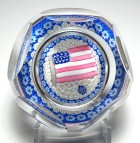 |
| 5393 | Large Whitefriars 1974 Multi-faceted
Carpet Ground Millefiori Paperweight. dated
1974. Wonderful design with a carpet ground of identical red
and white millefiori canes surrounded by a ring of lime green
canes. There is a clear ground underneath the design.
The paperweight is faceted with one top facet and a total of 30
side facets in three rows (12 small + six larger + 12 small side
facets). There is a Whitefriars signature cane with a white
monk and the year 1974 next to the outer ring. It comes with
a Whitefriars box, but probably not the original box. A
great addition to any collection of millefiori paperweights. Note about condition: I am rating the condition of this paperweight as very good. It has manufacturing flaws - some of the larger side facets were not polished and show parallel grinding marks. The paperweight displays beautifully. The price has been reduced. Modern Whitefriars paperweights are prized by collectors for their high quality glass and millefiori designs. The paperweights with mosaic canes are especially sought after. The name Whitefriars Glass dates from sometime in the 1600s. The original site had been occupied by a community of Carmelite monks known as White Friars, hence the name taken by the glass company. Some sources state that at least a portion of the company operated under the name of James Powell and Sons from 1834 to 1962. Other sources state that the Whitefriars name was used from 1680 to 1980. Limited production of millefiori paperweights and other millefiori items started some time in the 1930s and first appeared in the 1938 catalog. Millefiori items were made using English full lead crystal (33% lead oxide). It is difficult to associate specific paperweights with this production. After 1945, they made colored glass and bubble design paperweights until the modern millefiori production started about 1951. Even then relatively few designs were produced until the 1970s. In 1980, Whitefriars glass went out of business. After Whitefriars Glass was liquidated, Caithness Glass purchased the rights to the name and produced paperweights under the Whitefriars name for awhile. Large Size: Just under 3 1/16" diameter by 2"
high. The base is ground concave. Faceted with a
total of 31 facets, one top facet and 30 side facets in three
rows (12 + 6 + 12) For extra pictures, click on the picture at the right and the following links: Large pictureSOLD. Click on the picture to see a larger image. |
Click
on the picture to see a larger image |
| 5686 | Whitefriars Experimental Millefiori
Rectangular Slab Paperweight - with damage. dated
1972. This unusual paperweight is rectangular in shape with
about a eighteen millefiori canes running vertically from the top
to the bottom of the paperweight. The exception is that
there are also two Whitefriars 1972 signature date canes which are
only short segments. Most of the canes in the block are
clear stringers with a white enamel coating. It has the
typical heavy Whitefriars lead crystal. The paperweight is
signed with two Whitefriars signature canes with a white monk and
the date 1972 and also has a paper label that was used 1963 to
1979. With its unusual shape and rarity, this is a great
addition to any collection of millefiori paperweights. According to the Whitefriars Paperweights Collectors Guide by Brian Slingsby and Judy Taylor, this was an experimental item that was never launched as a catalog item due to the high production cost and the amount of flattening and hand polishing required. The number that were made is unknown. Note on condition: The condition of this paperweight is fair to good. It has a number of small chips and internal fractures on the edges and corners, but still displays nicely retaining its entertainment value. Please examine the pictures carefully. Modern Whitefriars paperweights are prized by collectors for their high quality glass and millefiori designs. The paperweights with mosaic canes are especially sought after. The name Whitefriars Glass dates from sometime in the 1600s. The original site had been occupied by a community of Carmelite monks known as White Friars, hence the name taken by the glass company. Some sources state that at least a portion of the company operated under the name of James Powell and Sons from 1834 to 1962. Other sources state that the Whitefriars name was used from 1680 to 1980. Limited production of millefiori paperweights and other millefiori items started some time in the 1930s and first appeared in the 1938 catalog. Millefiori items were made using English full lead crystal (33% lead oxide). It is difficult to associate specific paperweights with this production. After 1945, they made colored glass and bubble design paperweights until the modern millefiori production started about 1951. Even then relatively few designs were produced until the 1970s. In 1980, Whitefriars glass went out of business. After Whitefriars Glass was liquidated, Caithness Glass purchased the rights to the name and produced paperweights under the Whitefriars name for awhile. Size: 2 1/2" by 1 1/16" by just under 1 1/4"
high. All surfaces are polished flat. For extra pictures, click on the picture at the right and the following links: Large pictureSOLD. Click on the picture to see a larger image. |
Click
on the picture to see a larger image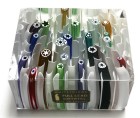 |
| 5906 | Large Whitefriars Multifaceted Six Ring
Red White & Blue Concentric Millefiori Paperweight. dated
1975. This paperweight has six concentric rings of red,
white, and blue millefiori canes around a center cane. The
paperweight is faceted with a ten sided top facet and many diamond
shaped side facets that are arranged in a spiral up to the top
facet. The faceting makes it look like there are many more
rings than the actual six ring setup. It has a Whitefriars
signature cane with a white monk and the date 1975 in the
outermost red ring (the fifth ring from the center). The
ground is clear crystal. Typical heavy Whitefriars lead
crystal. With its dramatic faceting and bold colors, this is
a very nice addition to any collection of millefiori
paperweights. Modern Whitefriars paperweights are prized by collectors for their high quality glass and millefiori designs. The paperweights with mosaic canes are especially sought after. The name Whitefriars Glass dates from sometime in the 1600s. The original site had been occupied by a community of Carmelite monks known as White Friars, hence the name taken by the glass company. Some sources state that at least a portion of the company operated under the name of James Powell and Sons from 1834 to 1962. Other sources state that the Whitefriars name was used from 1680 to 1980. Limited production of millefiori paperweights and other millefiori items started some time in the 1930s and first appeared in the 1938 catalog. Millefiori items were made using English full lead crystal (33% lead oxide). It is difficult to associate specific paperweights with this production. After 1945, they made colored glass and bubble design paperweights until the modern millefiori production started about 1951. Even then relatively few designs were produced until the 1970s. In 1980, Whitefriars glass went out of business. After Whitefriars Glass was liquidated, Caithness Glass purchased the rights to the name and produced paperweights under the Whitefriars name for awhile. Large size: Just over 3" diameter by just over 1
15/16" high. The base is ground concave. Faceted
with a ten sided top facet and many diamond shaped side facets
that are arranged in a spiral up to the top facet. For extra pictures, click on the picture at the right and the following links: Large picture$345 postage paid in the US. Click on the picture to see a larger image. |
Click
on the picture to see a larger image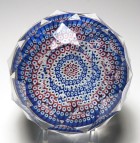 |
Back to Allan's Paperweights (www.paperweights.com)
Revised 7/18/2025 IE